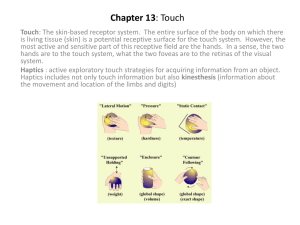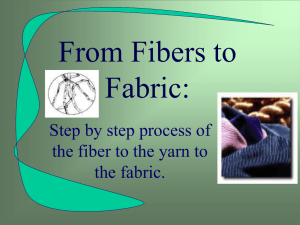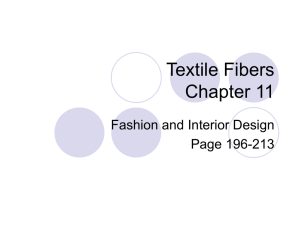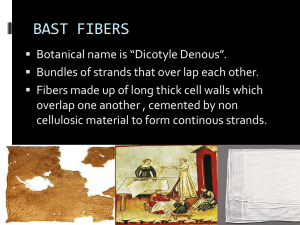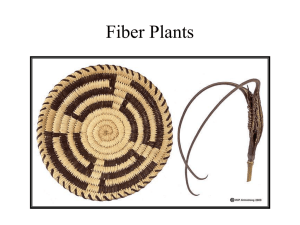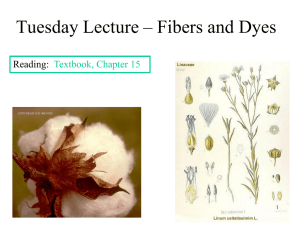Chapter 6: Textiles and Production
advertisement
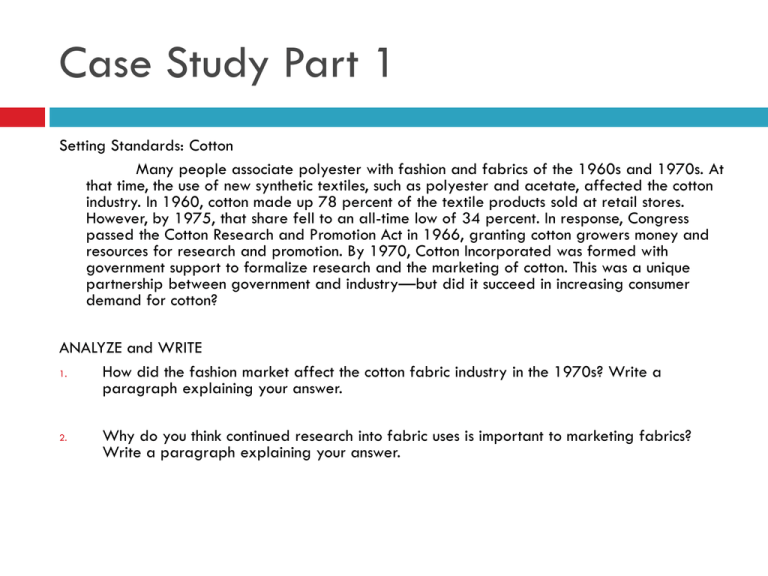
Case Study Part 1 Setting Standards: Cotton Many people associate polyester with fashion and fabrics of the 1960s and 1970s. At that time, the use of new synthetic textiles, such as polyester and acetate, affected the cotton industry. In 1960, cotton made up 78 percent of the textile products sold at retail stores. However, by 1975, that share fell to an all-time low of 34 percent. In response, Congress passed the Cotton Research and Promotion Act in 1966, granting cotton growers money and resources for research and promotion. By 1970, Cotton Incorporated was formed with government support to formalize research and the marketing of cotton. This was a unique partnership between government and industry—but did it succeed in increasing consumer demand for cotton? ANALYZE and WRITE 1. How did the fashion market affect the cotton fabric industry in the 1970s? Write a paragraph explaining your answer. 2. Why do you think continued research into fabric uses is important to marketing fabrics? Write a paragraph explaining your answer. CHAPTER 6: TEXTILES AND PRODUCTION 6.1 Textiles and Fashion What Will YOU Learn??? To discuss the fiber properties that determine appropriate use and quality of fabrics To identify the main natural fibers To identify the main manufactured fibers To explain the importance of fabric in fashion Fabric and Fibers Fabrics are ling pieces of cloth. Characteristics of Fibers: Fibers are thin, hair-like strands that are the basic units used to make fabrics and textile products. Different fibers have specific properties that affect the characteristics of fabric, such as: Appearance Strength Absorbency Warmth Shrinkage Price Types of Fibers and Yarns Fibers are spun into yarn, and the yarn is used the make fabrics. Yarn uninterrupted threads of textile fibers that are ready to be turned into fabrics. Different fibers can all be categorized as either natural or manufactured fibers. Leathers and furs are not fibers, but they are used I the apparel industry. Natural fibers can be plant or animal fibers. Manufactured fibers are either synthetic or cellulosic fibers. Synthetic fibers are composed of chemical compounds derived from petroleum or natural gas. Cellulosic fibers are made from plants combined with chemicals. Natural Fibers Natural Fibers are textile fibers made from plants or animals. Characteristics of Natural Fibers: Cotton Linen Wool Silk Leather/Suede and Fur Manufactured Fibers Manufactured fibers are fibers created by a manufacturing process of any substance that is not a fiber. Characteristics of Manufactured Fibers: Rayon Acetate Nylon Acrylic Polyester Spandex Microfibers Lyocell Fiber Trade Associations Cotton Incorporated – marketing and research organization National Cotton Council – the central organization of the cotton industry Woolmark Americans, Inc.—the U.S. subsidiary of The Woolmark Company Pty. Ltd., which promotes wool and wool blend products as well as licensing the Woolmark trademarks Mohair Council of America – the promotional organization for U.S. mohair producers Quiz 1. 2. 3. What are the four main natural fibers? What are the primary advantaged and disadvantages of leather/suede? What are three manufactured fibers that are cellulosic?
